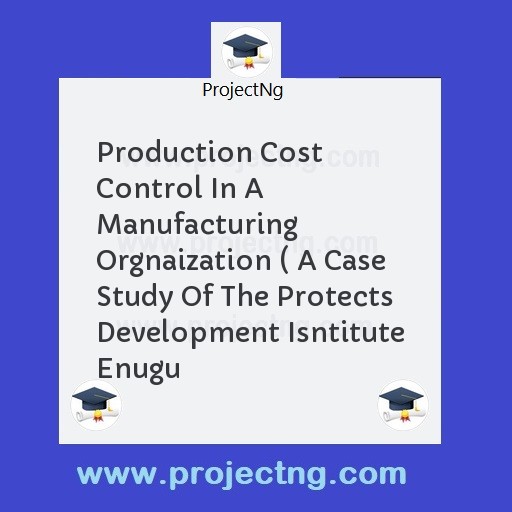Production Cost Control In A Manufacturing Orgnaization ( A Case Study Of The Protects Development Isntitute Enugu
Accounting Project Topics
Get the Complete Project Materials Now! »
PRODUCTION COST CONTROL IN A MANUFACTURING ORGNAIZATION ( A CASE STUDY OF THE PROTECTS DEVELOPMENT ISNTITUTE ENUGU
PROPOSAL
The target of most business organization is maximization of profit. Profit exists when the income obtained is above the expenditure. It is the excess of revenue over cost or expenditure. At times profit can only exist when there is an increase in selling price of the product or reduction in the cost of manufacturing. Since excessive price increase is dreaded by the public, it becomes vital to achieve the business objectives through production cost control of each product.
The necessity of production cost control is to bring about this research which is to be undertaken to give actual background on the cost control, the need for the control, cost items to be controlled and the effect of uncontrolled production costs on the organization.
In the course of this research, the researcher will encounter some constraints such as time constraints, financial constraint ad inadequate materials
Some recommendations will be made which if implemented will enhance abundant or more profit, quality product and control of raw materials.
LIST OF TABLES
1. Elements of a control system----------------------------------------18
2. Flow of cost------------------------------------------------------------25
3. Economic order Quality----------------------------------------------33
TABLES OF CONTENTS
PROPOSAL-----------------------------------------------------------------------
PREFACE-------------------------------------------------------------------------
ACKNOWLEDGEMENT------------------------------------------------------
LIST OF TABLES--------------------------------------------------------------
CHAPTER ONE
INTRODUCTION
1.1 BACKGROUND OF STUDY
1.2 STATEMENT OF THE PROBLEMS
1.3 OBJECTIVE OF THE STUDY
1.4 SIGNIFICANCE OF THE STUDY
1.5 SCOPE AND LIMITATION OF THE STUDY
1.6 DEFINITION OF TERMS
CHAPTER TWO
LITERATURE REVIEW
2.1 PRODUCTION COST CONTROL
2.2 COST REDUCTION
2.3 COST CONTROL
2.4 PRODUCTION COST
2.5 ACCOUNTING FOR ELEMENTS OF PRODUCTION COST
2.5.1 ACCOUNTING FOR MATERIAL COST
2.5.2 ACCOUNTING FOR LABOUR COST
2.5.3 ACCOUNTING FOR OVERHEAD COST
2.6 CONTROL
2.6.1 MATERIAL CONTROL
2.6.2 LABOUR COST CONTROL
2.6.3 PRODUCTION OVERHEAD CONTROL
2.7 COST CONTROL METHODS
2.7.1 BUDGETARY CONTROL SYSTEM
2.7.2 STANDARD COSTING
2.7.3 VARIANCES
CHAPTER THREE
RESEARCH DESIGN AND METHODOLOGY
3.1 AN OVER-VIEW
3.2 SOURCES OF DATA
3.3 SAMPLES USED
3.4 METHOD OF INVESTIGAITON
3.5 INFORMAITON FROM THE USE OF QUESITONNAIRE
3.6 PROBLEM ENCOUNTERED IN DATA COLLECTION PROCESS AND LIMITATIONS
CHAPTER FOUR
DATA ANALYSIS AND DISCUSSION
4.1 PRODUCTION COST ASCERTAINMENT AND CONTORL
4.2 MATERIAL COST
4.1.2 LABOUR COST
4.1.3 OVERHEAD COST
4.1.4 FIXED COST
4.2 COST CONTROL SYSTEM-BUDGETARY CONTORL
4.2.1 THE PRODUCTION BUDGET
4.3 INTERNAL CONTORL SYSTEM
4.3.1 OVERTIME AND PREPARATION OF WAGES
CHAPTER FIVE
FINDINGS, RECOMMENDATION AND CONCLUSION
5.1 FINDINGS
5.2 RECOMMENDATION
5.3 CONCLUSION
APPENDICES
APPENDICE A
NOTE
APPENDICES B
QUESTIONNAIRE
APPENDICE C
ORGNAIZATION CHART
BILIOGRAPHY
CHAPTER ONE
INTRODUCTION
1.1 BACKGROUND OF STUDY
The purpose of this research is a modest of attempt to verify the indiscriminate increase in the prices of commodities produced by manufacturing organization in this part of the country which has attracted the attention of many citizens, especially those who know the implications of this continuous rise continuous rise in prices on the people and on the nation’s economy.
This rapid increase in price of manufactured goods can be attributed to cost of production of goods and it is for this reason that the need for the control arises. Moreover, in compliance with the current drive towards structural Adjustment programme (SAP), these organizations are now caught up in the need to control their production cost.
This research paper will, therefore, attempt to give a comprehensive account of the control of costs in the field of production with particular emphasis on manufacturing organizations.
The feature of every organizations the pursuit of a goal and this goal or objective exists in different dimensions.
It is evident, therefore that every manufacturing organization, whether sole, partnership, corporation, among others, must have an objective and the primary objective of these organization is to maximize profit. Any other objective such as social service is purely secondary and generally dependent n profit.
Profit is the excess of total income over total cost during a specific period of time. It follows therefore, that for organizations to make profit, they must control over the cost of their productions and services.
Manufacturing is the transformation of materials into finished goods through the use of labour and factory facilities. It is clear that currently, the price of materials are so exorbitant to the extent that manufacturing companies are in a serious profit squeeze. They are struggling to maintain satisfactory earnings in a situation where costs are rising but some industrialist contend that profit increases are becoming more difficult to obtain ever at less proportionate degree to costs. Foreign and domestic competition as well as governmental efforts to prevent further inflation put serious restraints on additional increases. In addition to these, are governmental, (both or state and federal levels, stabilization measures aimed at re-structuring and improving the economy, and their attendant cost effect. Some of these measures like the second tier foreign exchange Market (SFEM)and structural adjustment programme have had the effects of not only causing increased prices as a result of increased cost of inputs, but have gone further to multiply in –built imported inflation by the incremental exchange rate of he Naira against the convertible currencies that are used in importation.
Be the First to Share On Social

Enjoying our content?
Don't miss out on new videos! Subscribe to our YouTube channel for more awesome content.
Subscribe Now!













